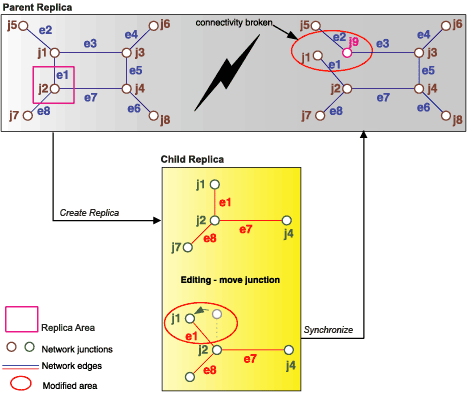Available with Standard or Advanced license.
Synchronizing geometric networks involves transferring data changes to the relative replica and rebuilding connectivity in any part of the network that has been modified. Areas of the network that are unaffected by synchronizing changes are not rebuilt.
Replica creation may add junctions that are outside the replica's filters to maintain data integrity. If these junctions are moved, new junctions will automatically be added at the old location on the relative replica when synchronized. If the junction is deleted, a new junction is added at the old location on the relative replica when synchronized. In this way, connectivity is maintained.
The following examples demonstrate the behavior of geometric networks during synchronization:
Example One
In this example, junction j1 is moved in the child replica. As junction j1 was replicated as a result of edge e1 being replicated to maintain valid connectivity, it is no longer connected to its other edges, e2 and e3, in the child replica. As these edges were not connected to junction j1 at the time it was moved, network connectivity is broken when the data is synchronized with the parent replica.
Once the changes are synchronized, the connectivity in the modified section of the network is rebuilt. This will result in a new junction, j9, being created automatically to maintain the correct prereplication network connectivity between edges e2 and e3.

Example two
In the next example, a collection of edges and junctions in a network is replicated. In the child replica, a complex edge that connected numerous simple edges to the rest of the network is deleted. The data is then synchronized with the parent replica. In this case, connectivity is again broken, but editing the data in the child replica resulted in the same connectivity as if the edge had been deleted in the parent replica.
If the modifications in the child replica result in network connectivity being broken in the parent replica, the responsibility for correcting this remains with the user or data administrator.
